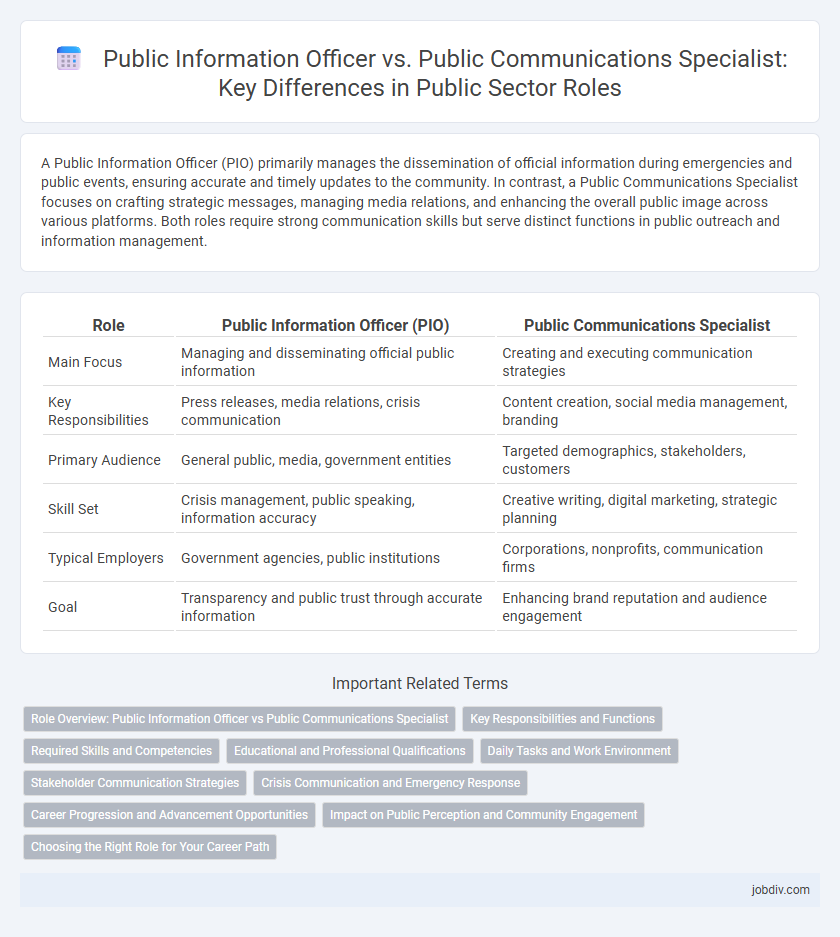A Public Information Officer (PIO) primarily manages the dissemination of official information during emergencies and public events, ensuring accurate and timely updates to the community. In contrast, a Public Communications Specialist focuses on crafting strategic messages, managing media relations, and enhancing the overall public image across various platforms. Both roles require strong communication skills but serve distinct functions in public outreach and information management.
Table of Comparison
| Role | Public Information Officer (PIO) | Public Communications Specialist |
|---|---|---|
| Main Focus | Managing and disseminating official public information | Creating and executing communication strategies |
| Key Responsibilities | Press releases, media relations, crisis communication | Content creation, social media management, branding |
| Primary Audience | General public, media, government entities | Targeted demographics, stakeholders, customers |
| Skill Set | Crisis management, public speaking, information accuracy | Creative writing, digital marketing, strategic planning |
| Typical Employers | Government agencies, public institutions | Corporations, nonprofits, communication firms |
| Goal | Transparency and public trust through accurate information | Enhancing brand reputation and audience engagement |
Role Overview: Public Information Officer vs Public Communications Specialist
A Public Information Officer (PIO) primarily manages the dissemination of information to the public and media, ensuring accurate and timely updates during emergencies or public events. In contrast, a Public Communications Specialist focuses on developing strategic communication plans, crafting messages, and managing public engagement across various platforms. Both roles require strong communication skills, but the PIO emphasizes crisis communication and official information release, while the Communications Specialist targets broader audience engagement and brand messaging.
Key Responsibilities and Functions
A Public Information Officer (PIO) primarily manages the dissemination of accurate, timely information to the public and media, often serving as the official spokesperson during emergencies or public events. Their key responsibilities include drafting press releases, coordinating media interactions, and ensuring compliance with public information laws. In contrast, a Public Communications Specialist focuses on crafting and implementing communication strategies, developing content for various platforms, and engaging with target audiences to promote organizational goals and enhance public perception.
Required Skills and Competencies
Public Information Officers must have strong crisis communication, media relations, and message discipline skills to effectively manage information flows during emergencies. Public Communications Specialists require expertise in content creation, digital marketing, and audience engagement to develop targeted messaging across multiple platforms. Both roles demand excellent interpersonal skills, strategic thinking, and proficiency in communication technologies.
Educational and Professional Qualifications
A Public Information Officer typically requires a bachelor's degree in communications, public relations, or a related field, with many positions favoring candidates who have professional certifications like the Accredited Public Relations (APR) credential. In contrast, a Public Communications Specialist often holds a degree in journalism, marketing, or media studies and may have specialized training in digital media, content creation, or social media management. Both roles benefit from strong writing, public speaking, and strategic communication skills, but the Public Information Officer generally emphasizes government or organizational policy knowledge, while the Specialist focuses more on media relations and audience engagement tactics.
Daily Tasks and Work Environment
Public Information Officers manage official communications, draft press releases, coordinate with media, and handle crisis communications in often high-pressure government or organizational settings. Public Communications Specialists focus on creating content for various platforms, developing communication strategies, and managing social media engagement within corporate or nonprofit environments. Both roles require strong writing skills and media relations, but Public Information Officers typically work in fast-paced, public-facing scenarios, while Communications Specialists have a broader scope involving brand messaging and audience engagement.
Stakeholder Communication Strategies
Public Information Officers (PIOs) develop crisis-focused stakeholder communication strategies to ensure timely and accurate dissemination of information during emergencies. Public Communications Specialists design broader engagement plans targeting diverse audiences to enhance community relations and promote organizational initiatives. Both roles utilize tailored messaging frameworks that prioritize clarity, transparency, and audience-specific information channels for effective stakeholder outreach.
Crisis Communication and Emergency Response
Public Information Officers (PIOs) specialize in delivering timely, accurate information during crisis communication and emergency response, acting as the authoritative voice for government agencies. Public Communications Specialists focus on crafting strategic messaging and managing media relations before, during, and after emergencies to ensure consistent public engagement. Both roles are critical in disseminating information that mitigates risks and promotes public safety during emergencies.
Career Progression and Advancement Opportunities
Public Information Officers typically advance by gaining expertise in media relations and crisis communication, often progressing to senior roles within government or large organizations. Public Communications Specialists can expand their career through diverse industries, leveraging skills in content strategy and digital communication to move into communications director or brand management positions. Both roles offer growth potential, but Public Information Officers frequently focus on public sector leadership, while Public Communications Specialists pursue broader corporate or nonprofit opportunities.
Impact on Public Perception and Community Engagement
A Public Information Officer (PIO) shapes public perception by delivering timely, accurate information during crises, enhancing trust and transparency between government agencies and the community. A Public Communications Specialist focuses on crafting strategic messaging and managing media relations to foster ongoing engagement and support for public initiatives. Both roles are critical in maintaining positive community relations but differ in emphasis: PIOs prioritize immediate information dissemination while Communications Specialists build long-term public awareness and involvement.
Choosing the Right Role for Your Career Path
Public Information Officers manage official communications and act as primary liaisons between organizations and the public, focusing on transparency and crisis management. Public Communications Specialists develop strategic messaging and marketing campaigns to enhance brand reputation and audience engagement across multiple platforms. Choosing the right role depends on your strengths in media relations and crisis response for Public Information Officer or content creation and strategic outreach for Public Communications Specialist.
Public Information Officer vs Public Communications Specialist Infographic

 jobdiv.com
jobdiv.com